To get an idea about how I feel about Saturday's opening at Fuse Gallery NYC, take this word: WOW. Highlight it with your mouse and copy it. Then open your favorite text editor and paste it 100 times. That's how I feel about the opening: WOW.
I found out about it entirely by accident. As I wrote in the Plan Ahead section, I was over at Cory Marc's looking at the Seattle Erotic Festival Website. Cory got in; I did not. So I was bitterly tearing apart all the lousy art on display when Cory asked me if I knew John John Jesse's work. John (John John?) got into the Seattle show, too, but I don't feel bad about it because his work totally rules, which I found out when I visited his Website. Who knows what moves festival juries? They pick excellent work like John John Jesse and François Dubeau, and then they pick total crap like this guy. What's with this guy, seriously? Could he suck any harder? I'm not even going to use his name in case he's got a Google alert, that's how bad he is.
John John Jesse has a bunch of links off to other artists, one of whom is Madeline von Foerster. His link is broken but I'm persistent when I want to be and I found her current site. Her paintings looked excellent online and, oh happy day, she posted that she would be opening at Fuse in just a few days. She'd be sharing with Melissa Murray, whose work also looked good, so I put Fuse on my calendar for Saturday in the hopes that I'd be able to make it.
I did make it and I'm glad I did. I don't know if I picked up a contact high from the miasma in Fuse -- smelled like incense, but who knows? -- or if maybe it was the six cups of bad coffee I'd had earlier -- I don't usually drink coffee -- but I'm still excited today. This one little opening over on the Lower East Side has more energy and technique than every show I've seen in Chelsea so far combined (if you set Inka Essenhigh aside, anyway).
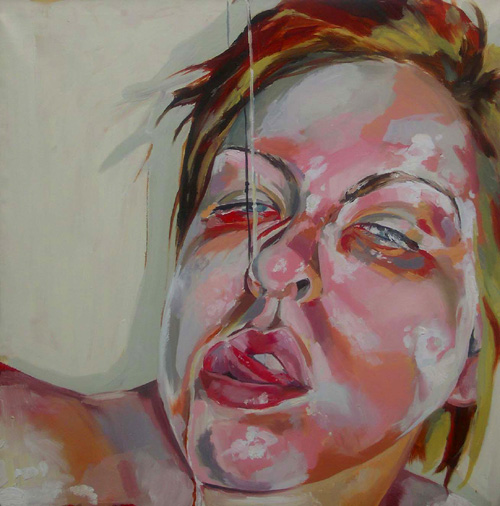 The Fuse gallery space sits behind your standard New York City bar. New York architecture being the random thing it is, two doors lead into the same back room. I took the one on the left (always go left) and found myself in a small hallway which forms an L with the main gallery room. Melissa Murray's work was hung here and then on the left half of the larger space. I first found a series of self-portrait photographs of Melissa, opposite the show's signature piece, "Compassion." Next to the photos a number of small pencil drawings pinned to the wall made up one piece. A swarm of wasps invaded Melissa's orifices in this one. I was happy to see vulva -- who doesn't like vulvae? -- until I saw a wasp making its way inside.
The Fuse gallery space sits behind your standard New York City bar. New York architecture being the random thing it is, two doors lead into the same back room. I took the one on the left (always go left) and found myself in a small hallway which forms an L with the main gallery room. Melissa Murray's work was hung here and then on the left half of the larger space. I first found a series of self-portrait photographs of Melissa, opposite the show's signature piece, "Compassion." Next to the photos a number of small pencil drawings pinned to the wall made up one piece. A swarm of wasps invaded Melissa's orifices in this one. I was happy to see vulva -- who doesn't like vulvae? -- until I saw a wasp making its way inside.
The photographs and pencil drawings are slightly different from Melissa's other works here, which are all of the artist in masochistic or otherwise tortured poses. She paints big and bold and bright, but what she's painting is unpleasant and mildly disturbing. In conversation she told me she's exploring the masochism of creating one's self-image -- at least that's what I understood. From the paintings you'd expect Melissa to be unattractive, fat, debased; I've known people who fit her paintings. But Melissa herself turns out to be adorable, sweet, and anything but obese. I told her she was very brave to portray herself as she does, wrapped in duct tape or with a pear shoved into her mouth and held with packing tape. Even when she's just having something sticky poured on her face, she looks depraved. The photos she takes -- which she uses as references for her paintings -- are unsparingly unflattering. And sticky: Not just the subjects (oozing fluids, adhesives, runny mascara) but also the paint itself, which she clearly throws on with abandon using broad brushes.
I hope I haven't given you the idea that I don't like Melissa's paintings; I do. They're very good. But they're not nice. Which is fine -- art doesn't have to be nice. Still, I can't help but think Melissa would be even better if she'd channel some of her true personality and attractiveness into her paintings. What she has is excellent; what she could have, I think, is even better. Whether she adds some pleasantry in or not, as she matures she's going to be worth watching.
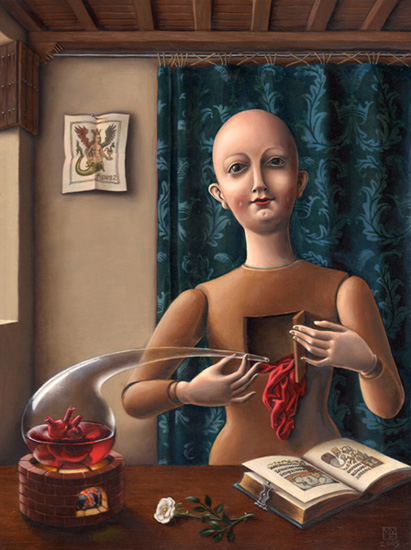 Meanwhile on the other side of the room Madeline von Foerster's paintings await. The very first thing I said to Madeline, after spending some time absorbing her paintings, was, "I am in love." That's it right there. That's what happened: I fell in love. On the way home from New York I heard "Light My Fire," of course by the Doors, on the radio and I realized right then: Madeline's paintings are the visual equivalent of the Doors' music, where harpsichord and funky backbeats blend, where the Dionysian of Jim Morrison's train wreck meets Robby Krieger's Apollonian precision and the two agree to a truce so they can rock your ass off. Sorry to get all freshman-year-lit-thesis here, but that's what these paintings did to me. They grab your head and heart and don't let either go.
Meanwhile on the other side of the room Madeline von Foerster's paintings await. The very first thing I said to Madeline, after spending some time absorbing her paintings, was, "I am in love." That's it right there. That's what happened: I fell in love. On the way home from New York I heard "Light My Fire," of course by the Doors, on the radio and I realized right then: Madeline's paintings are the visual equivalent of the Doors' music, where harpsichord and funky backbeats blend, where the Dionysian of Jim Morrison's train wreck meets Robby Krieger's Apollonian precision and the two agree to a truce so they can rock your ass off. Sorry to get all freshman-year-lit-thesis here, but that's what these paintings did to me. They grab your head and heart and don't let either go.
Madeline's style is -- I don't want to say old-fashioned. Her paintings hark back to before the Renaissance, with elements of symbolism and the still life; small landscapes; and the posed, preserved quality of Byzantine religious icons. The best way I can describe it is to talk about other painters: Have you ever seen Dali's "The Persistence of Memory" in person, and stood so close to it your nose was almost touching it -- I really mean so close the security guard edges closer in case you suddenly start licking it or something -- and have you looked at the tiny blips of paint, the nearly microscopic lines and dots, and wondered how the hell he painted like that? Madeline's paintings have the same magnetism. The hermetic quality of Bosch, the paint handling of Dali, the smooth, luminous surface of... darn, I know I've seen it somewhere. Giotto? Van Eyck? Botticelli? It's the egg tempera -- she paints in egg tempera and oils now, although her earlier works are straight oils.
Madeline's subjects are based in the language of alchemy, magick, and the Tarot. On her Website she calls herself an illustrator, which only makes me respect her more; too many people decide to call themselves artists when the title is really one others should bestow upon you. So her paintings have been commissioned in some cases, with specific purposes in mind. That makes them no less beautiful but it does make reading them a bit of a challenge. Even when she paints something as simple as a baboon holding its baby, I found myself peering intently at it looking for the subtext (beyond that supplied by the bulldozers off in the distance behind the apes). Madeline's world is populated with sphinxes and moths and sumptuous drapery, dryads who sculpt themselves out of trees, carved acorns, and night skies. The phrase "wealth of detail" comes to mind, but it also falls short. I think she puts her paintings together molecule by molecule.
And Madeline herself is beautiful. I know I'm not supposed to care what the artist looks like -- and if her art sucked, I wouldn't care at all -- but, I'm sorry, I respond to beauty, whether it's in a painting, a tree, a line of charcoal, or a person. And Madeline is as beautiful as her paintings, a perfect example of an artist whose creations flow from who she is. We spoke a bit before she had to mingle again, about how she wants to open in Chelsea sometime, and how she paints (there's a lot of layering). She made me feel like an old friend. Call it salesmanship -- if I'd had the disposable income (instead of scraping to afford the tunnel toll) I would've walked out with one of her paintings -- but to me, both the artist and her works look nothing but sincere.
I drove out of New York that night feeling higher than I have in weeks. Eager to paint, draw, anything. Maybe I had too much coffee. Maybe there was something funny in the air at Fuse. Maybe I'd just had a good day. But I like to think it was the art that did it.
Two feet from the canvas, the glint on Rembrandt's potato nose becomes a blob of white paint and the puckers in Titian's sleeve turn into flat slaps of umber on a blue ground. We turn these marks back into velvet and sweaty skin by making the right guesses. The painters force us to.
Jan van Eyck's extraordinary achievement rests on the fact that he did the opposite. In his paintings, he extended detailed information about things far past the ordinary limits of scrutiny; his eye acted "both as a telescope and as a microscope", and it left us with too much, not the suggestive too little of other realist art.
-- From Robert Hughes, introduction to "The Complete Paintings of the Van Eycks" via Mark Harden's Artchive
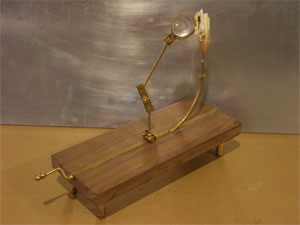 Seth is a sculptor, I guess you'd say: He assembles these contraptions out of metal tubing and animal teeth and wooden boxes and magnifying lenses and cranks and other odds and ends, creating what look like things out of a Victorian dream filtered through a whimsical Clive Barker. If you can imagine such a thing.
Seth is a sculptor, I guess you'd say: He assembles these contraptions out of metal tubing and animal teeth and wooden boxes and magnifying lenses and cranks and other odds and ends, creating what look like things out of a Victorian dream filtered through a whimsical Clive Barker. If you can imagine such a thing.
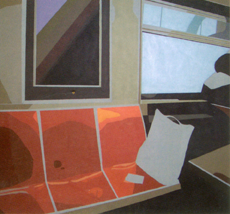 I spent my time looking over the gallery's current show, "Interiors" by Douglas Czuszak. Douglas' paintings remind me of Brian Alfred's, although they lack some of his precision. They're slightly more emotional. Still, Douglas' work has a certain coldness to it, a distance. They're supposedly of memories but don't have the warmth or ambiguity I'd expect from a memory; there's no sentimentality and, to me, little sentiment. These paintings are spare, sparse, and a bit empty.
I spent my time looking over the gallery's current show, "Interiors" by Douglas Czuszak. Douglas' paintings remind me of Brian Alfred's, although they lack some of his precision. They're slightly more emotional. Still, Douglas' work has a certain coldness to it, a distance. They're supposedly of memories but don't have the warmth or ambiguity I'd expect from a memory; there's no sentimentality and, to me, little sentiment. These paintings are spare, sparse, and a bit empty.
![[Alexandra Pacula]](/blog/images/20060323/alex_pacula.gif)
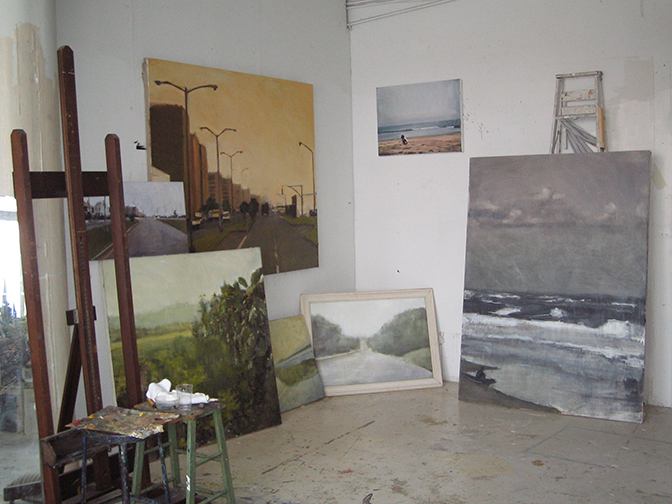 I did make it to
I did make it to 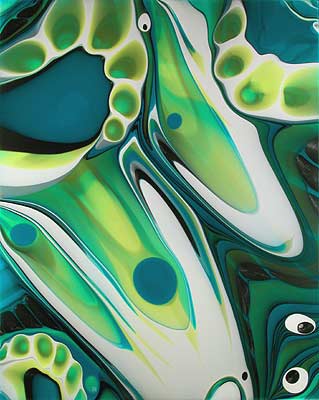 Just about right next door on the same floor as Lyons Wier is
Just about right next door on the same floor as Lyons Wier is 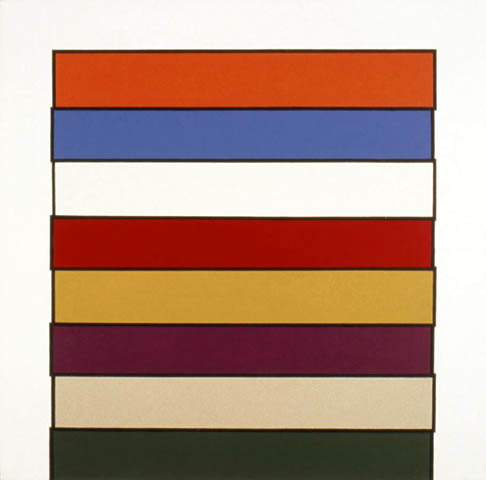 My immediate impression was that here was a painter who'd looked at
My immediate impression was that here was a painter who'd looked at 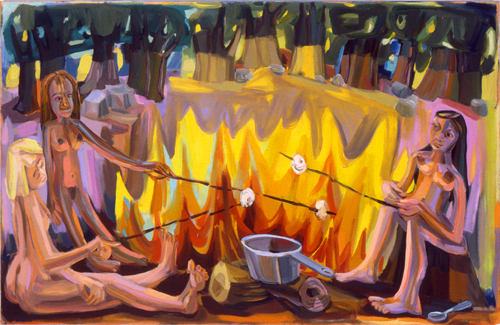 I can't say I was overwhelmed by Judith's work. I had looked her up when news of her opening hit the Douglas Kelley Show list since I look up almost everyone while planning my gallery trips. Her paintings didn't strike me as anything I wanted to see all that badly. I was right about that to some extent -- I didn't need to see her show.
I can't say I was overwhelmed by Judith's work. I had looked her up when news of her opening hit the Douglas Kelley Show list since I look up almost everyone while planning my gallery trips. Her paintings didn't strike me as anything I wanted to see all that badly. I was right about that to some extent -- I didn't need to see her show.
 There were a few interesting bits. Colleen Asper's "The Portrait of the Artist as President" was really stunning in terms of technique; a real old-school photorealist, she managed to efface all of her brushstrokes and leave a smooth, luminous surface. (Reproductions never do justice to oils, but this one is especially egregious; trust me, at full size, in person, it looks a lot better.)
There were a few interesting bits. Colleen Asper's "The Portrait of the Artist as President" was really stunning in terms of technique; a real old-school photorealist, she managed to efface all of her brushstrokes and leave a smooth, luminous surface. (Reproductions never do justice to oils, but this one is especially egregious; trust me, at full size, in person, it looks a lot better.)
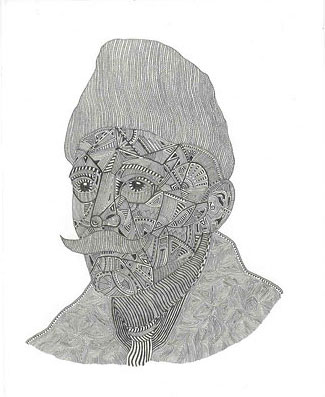 Timothy Hull's tiny drawing "Somewhere Between Real and Remembered" was neat, a little pencil portrait of Proust filled with little patterns and hatching and so forth. I have a weakness for drawings by obsessives; my father used to doodle like that, and I have a ton of similar doodles myself, so I tend to feel happy just seeing other people with the same penchant. I'm never sure they qualify as "art" and not, you know, doodles, but I like to see them anyway.
Timothy Hull's tiny drawing "Somewhere Between Real and Remembered" was neat, a little pencil portrait of Proust filled with little patterns and hatching and so forth. I have a weakness for drawings by obsessives; my father used to doodle like that, and I have a ton of similar doodles myself, so I tend to feel happy just seeing other people with the same penchant. I'm never sure they qualify as "art" and not, you know, doodles, but I like to see them anyway.
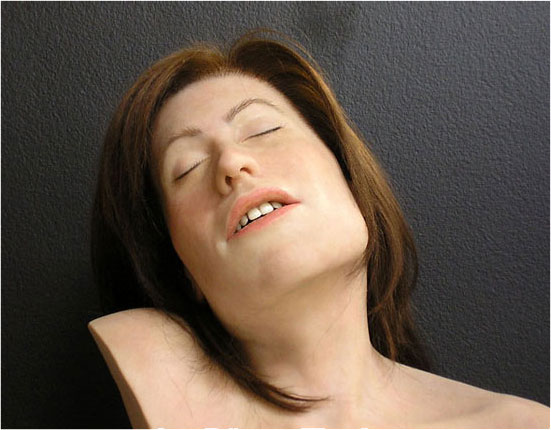 Finally there was Jill Magid. This sculpture of her head was entrancing, in a way, because -- the photo doesn't quite communicate this -- it actually looked alive, like it might wake up and move around. It doesn't look like a real head by a long shot, which is what made it strange; the proportions are off and it's clearly constructed. But it still has that creepy quality you get from the Real Dolls, that it might, in fact, be alive and just waiting for the right moment to move. In the looseleaf notebook there were a lot of pages devoted to Jill; if they weren't almost totally unreadable they might have been interesting. Apparently she works with or around or near actual forensic pathologists and uses what she sees and learns in her art. And maybe she puts together faux crime scenes; I couldn't figure out what was going on. Still, that sounds more in the spirit of surrealism than most of, well, anything I've heard in a while.
Finally there was Jill Magid. This sculpture of her head was entrancing, in a way, because -- the photo doesn't quite communicate this -- it actually looked alive, like it might wake up and move around. It doesn't look like a real head by a long shot, which is what made it strange; the proportions are off and it's clearly constructed. But it still has that creepy quality you get from the Real Dolls, that it might, in fact, be alive and just waiting for the right moment to move. In the looseleaf notebook there were a lot of pages devoted to Jill; if they weren't almost totally unreadable they might have been interesting. Apparently she works with or around or near actual forensic pathologists and uses what she sees and learns in her art. And maybe she puts together faux crime scenes; I couldn't figure out what was going on. Still, that sounds more in the spirit of surrealism than most of, well, anything I've heard in a while.
 His scumbling of white definitely shows the hand of the painter at work. I can easily see any of these as being the kind of painting you could hang on your wall and stop to look at every so often, noting new details and nuances each time.
His scumbling of white definitely shows the hand of the painter at work. I can easily see any of these as being the kind of painting you could hang on your wall and stop to look at every so often, noting new details and nuances each time.
![[John Avelluto]](/blog/images/20060309/john_avelluto.jpg) Speaking of archival nightmares, a number of the paintings in this show appear to be layered epoxy. This gives a nice, candy-like surface -- the epoxy drips off the sides of the paintings as it dries, leaving a wacky edge when you check behind them -- and the paint between the layers makes for an interesting dimensional effect. But I have it from my favorite curator Jeanne that epoxy has a nasty habit of yellowing and cracking as it ages. And in fact one piece, a plug-in with a lightbulb behind it (and which was unlit), is already yellowing.
Speaking of archival nightmares, a number of the paintings in this show appear to be layered epoxy. This gives a nice, candy-like surface -- the epoxy drips off the sides of the paintings as it dries, leaving a wacky edge when you check behind them -- and the paint between the layers makes for an interesting dimensional effect. But I have it from my favorite curator Jeanne that epoxy has a nasty habit of yellowing and cracking as it ages. And in fact one piece, a plug-in with a lightbulb behind it (and which was unlit), is already yellowing.
![[John Avelluto]](/blog/images/20060309/john_avelluto.2.jpg) Curatorial concerns aside, I was unimpressed by the work in this show. 1980s videogames don't strike me as very interesting, especially not when used for heavy-handed, obvious political messages. Ooh, racial profiling is like a videogame, wow, man. Bong-inspired paintings don't do much for me, either: Super Mario's head floating above a Pollock-like background with slices of real pepperoni layered in the epoxy doesn't seem all that wildly imaginative to me, just a little pointless and wacky.
Curatorial concerns aside, I was unimpressed by the work in this show. 1980s videogames don't strike me as very interesting, especially not when used for heavy-handed, obvious political messages. Ooh, racial profiling is like a videogame, wow, man. Bong-inspired paintings don't do much for me, either: Super Mario's head floating above a Pollock-like background with slices of real pepperoni layered in the epoxy doesn't seem all that wildly imaginative to me, just a little pointless and wacky.
![[Inka Essenhigh]](/blog/images/20060304/inka_essenhigh.2.jpg) You may have seen
You may have seen  Mary Boone's gallery is so cavernous it dwarfs all but the most massive installations. Brian had painted large to fill the space but even so, both the paintings and the number of visitors seemed small and sparse in comparison. This meant I was able to get a really good, long look at his paintings, though, which isn't common at openings; and I could talk to the artist for a good long while.
Mary Boone's gallery is so cavernous it dwarfs all but the most massive installations. Brian had painted large to fill the space but even so, both the paintings and the number of visitors seemed small and sparse in comparison. This meant I was able to get a really good, long look at his paintings, though, which isn't common at openings; and I could talk to the artist for a good long while.
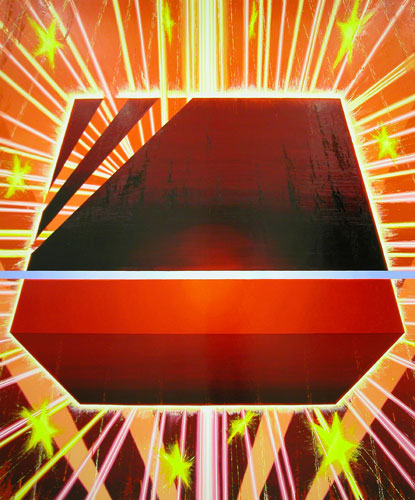
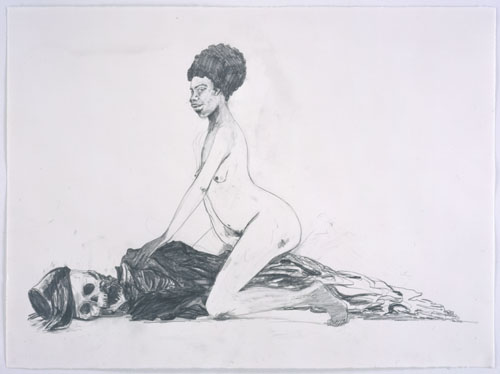 Sikkema Jenkins had two openings, one for a group show, "Turn the Beat Around," and one for Kara Walker. The group show had some pretty lousy art -- I found the young girl from Inka's opening staring quizzically at what appeared to be a poorly made prosthetic leg standing in the middle of the room -- and two good paintings, one of which I found an image for and put here. Marc Handelman's "Raptus" was kind of neat. Very energetic and big, kind of wacky. Most of what was on the walls otherwise, and also on the floor, was pure dreck. I didn't even try to find out who did what or why.
Sikkema Jenkins had two openings, one for a group show, "Turn the Beat Around," and one for Kara Walker. The group show had some pretty lousy art -- I found the young girl from Inka's opening staring quizzically at what appeared to be a poorly made prosthetic leg standing in the middle of the room -- and two good paintings, one of which I found an image for and put here. Marc Handelman's "Raptus" was kind of neat. Very energetic and big, kind of wacky. Most of what was on the walls otherwise, and also on the floor, was pure dreck. I didn't even try to find out who did what or why.

